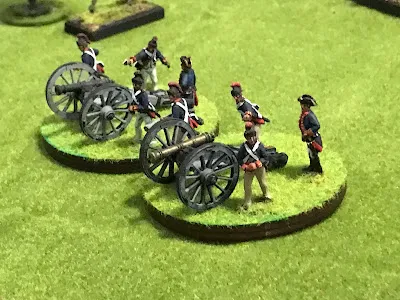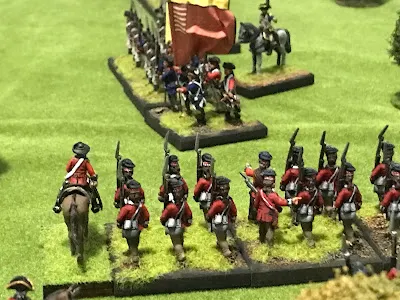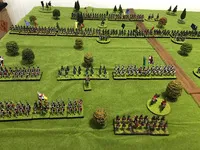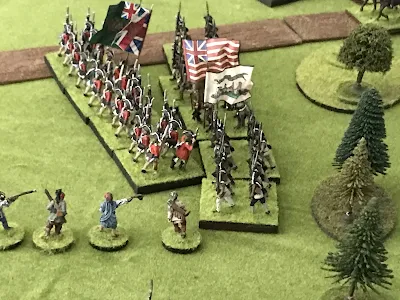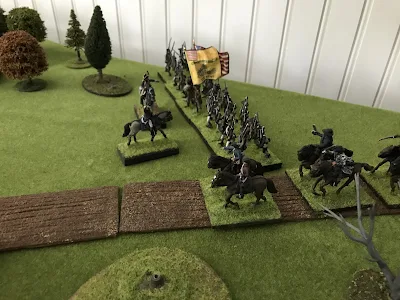British advance against the American militia line. Artillery fire causes one militia regiment to rout. Units to either side check and one regiment in second line is nervous but holds. Brigade commanders are busy holding their men together.
Webster's brigade advances into musket range. A devastating volley turns the militia line into ruin and regiments break and retreat.
On the opposite flank the 2nd Maryland brigade advances against the Loyalist line. Both sides exchange volley fire and both sides stand steady.
Delaware Regiment confronts the Legion infantry and Volunteers of Ireland.
2nd Maryland Brigade faces Rawdon's Loyalist Brigade whole the 1st Maryland brigade moves to protect the flank.
At this point following a close range volley from Webster's brigade the militia line collapsed. All American Militia regiments are either all retreating or routed. The British commander now charges forward into this mess and completes the rout of the American left flank.
2nd Maryland brigade closes the gap.
Seeing this Gates quickly moves the 1st Maryland brigade to cover his exposed flank. One militia regiment holds, but for how long?.
Tarleton, moves the Legion cavalry forward getting ready for a decisive charge.
The American general Gates was swept up in the rout of the Virginia and North Carolina militia brigades. Although some units managed to rally, the advancing British infantry quickly routed them and cleared the field. The British Legion cavalry rode down the isolated American gunners silencing most of the artillery.
Ignoring the defeat and rout of the Militia, the 2nd Maryland Brigade went on the offensive. Charging forward the Delaware regiment charged the Legion Infantry while the 2nd/4th Maryland regiment took on the North Carolina Volunteers. Both regiments won their fights and the loyalists retreated back. To add insult to injury the Continental artillery fired a load of canister at the Volunteers of Ireland which caused a morale check.
Rawdon rallied his line regiments but the loyalist militia panicked and ran. Cornwallis ordered up the 2nd /71st to help hold the flank. Webster redeployed his brigade to attack the 1st Maryland brigade.
With Gates having been swept away in the retreat of his militia, Baron De Kalb remained with his Marylanders and Delaware regiments. Ordering Smallwood to hold his flank he charged forward to attempt to push the Loyalist brigade out if his way. Already weakened, and with the loyalist militia not wanting any part of the fight they were watching the line broke.
The Maryland and Delaware regiments fired and charged causing high casualties and both defeated their opponents in the melee. The Legion Infantry was destroyed while left the NCV broke and routed.
On the flank the 5th /6th Maryland regiment fired a devastating volley into the Volunteers of Ireland causing high casulties. In addition the remaining Continental artillery joined them and the combined casualties were too much for the VoI who routed back. At least on this flank the Americans appeared to have some success.
The 71st moved up onto the flank of the Delaware regiment and fired a volley into their flank. Their morale held, but just.
After the Royal Artillery added their firepower Tarleton launched his Cavalry into the Maryland regiment. A long range volley caused some casualties but the dragons crashed into the Continental and defeated them, capturing their colors and killing their colonel. They also over ran the the artillery.
At this point, the British had broken through and both groups of Continentals were isolated. De Kalb ordered a retreat to try and save what he could of his command. It had been a brave stand but the early rout of the militia had doomed his small command.
Thus ended our game of the Battle of Camden. The results mirrored the actual results of the historical battle with the early rout of the militia and the Continental line fighting steadily.
Although one sided it did provide a fun game. Perhaps if the Militia could have held out a little longer? I suspect the historical set up doomed the American side. Another time perhaps a different set up or on a different field might result in a different result. After all the American army here was very similar to what Greene later fought with at Guilford Courthouse.
And for someone wishing to start a small American Revolution wargame army Cornwallis' army here would make a ideal force. A Brigade if British Regulars, A Brigade of Loyalists, two battalions of the 71st and the British legion. There is a very nice army for you!



.jpg)

.jpg)
.jpg)






